
Basketball Coaching DVD's at Championship Productions
ZONE OFFENSE
Thanks to Syracuse, West Virginia, Baylor and others, the prevalence of zone
defenses have taken shape in college basketball. Moreover, there are teams
on the high school levels and even some professional teams that feature some
sort of zone defense as a part of their defensive schemes. Because of
this, offenses need to find ways to run a solid and consistent offense against
zone defenses. This article will provide you with three types of zone
offenses and ways that you can teach them to your team so that you can be
prepared when you face a zone defense team.
The Need for Zone Offense
With the increasing popularity in playing multiple defenses, several teams have
decided to start playing zone defenses. In being a team prepared for a
zone (either by surprise or knowing in advance thanks to scouting), you will
need to have some sort of zone offense for these situations. If not, your
players will become confused at this defense that you have not prepared them for
in advance of the game.
Concepts Designed to Defeat Zone Offenses
When putting together a zone offense, there are a number of concepts that can be
used. These concepts are:
-
Filling the natural gaps of the zone.
Zone defenses rely on players guarding area, not specific players.
By getting into the right alignment against a given zone, we can get
certain players to be guarded by two players or to be left wide open
if they are aligned in the natural gaps of the zone.
-
Post penetration. Even though the zone
defense is designed to take away the middle of the floor, this does
not mean that the zone completely eliminates post penetration by the
offense. We can find ways to get the ball inside and continue
to honor the post even against a zone defense.
-
Ball and player movement to attack the zone.
When we use the pass and cutters, we are never using passing and
cutting for the sake of passing and cutting. All of our
offensive actions must be done with a purpose. When we pass,
we want to always honor the post area or skip the ball if at all
possible. Also, players cannot stay stationary against a zone
because that affords the zone defense the luxury of not having to
expend itself as much as we would like.
-
Proper use of screens. When we run our
zone offense, we need to know which defensive players to screen
based on the slides of the zone. We also want our players to
learn how to cut off of screens properly if they are using the help
with cuts.
-
Use of the dribble. One way that we can
attack a zone is by using the dribble wisely. Many teams that
play zone are accustomed to passing as a way to move the ball.
By having this extra added weapon at our disposal, we create a new
situation that the zone has to defend.
-
Utilization of personnel. Our players
have to be put in positions in the zone offense to be successful.
Not every player who plays basketball can shoot the three-point shot
or score from the low post. Against zone defenses, we can put
players in specific spots and allow them to be successful doing what
they do best.
-
Ball and shot fakes. This is an
underrated part of zone offense because the zone is so predicated on
ball movement. Players are anticipating what the ball does
more than what the actual offense does. Shot fakes by
offensive players can force the defensive players in the zone to
raise their hands above their head, allowing for some advantageous
passing angles. Pass fakes can get the zone to move allowing
passing angles that were once thought to be impossible.
If I had to sum it all up in a sentence, I would say that our zone offense
concepts would be to get in the zone natural gaps and attack the zone with
purpose using basic basketball fundamentals of cutting, passing, dribbling,
screening and ball fakes. Using these concepts, I have designed a method
of attacking zone defenses by putting all of these offensive concepts into a
structure that is simple and players can enjoy running in a game.
Types of Zone Offense
When choosing a type of zone offense, the philosophy is simple: use a zone
offense alignment that allows your offense to attack the gaps of the zone.
For this, we have two types of zone offenses that we will use to attack the two
types of zone alignments.
The first type of zone offense is the odd-guard front zone offense. The
odd-guard front zone offense is designed to work against 2-3 and 2-1-2 zones
because of the even-guard front nature of both of these zone defenses.
The second type of zone offense is the even-guard front zone offense. The
even-guard front zone offense has been created to work against 1-3-1, 1-2-2 and
3-2 zones because all three of these types of zones employ odd-guard fronts.
When we talk to our players about zone offense, we remind them that we run our
even-guard front zone offense against odd-guard front zones and our odd-guard
front zone offense against even-guard front zones.
Odd-Guard Front Zone Offense
The first of these alignments is what we call "2-Down". In this zone
alignment, we will put #4 and #5 in the short corners and #2 and #3 just below
the free-throw line extended. #1 will assume the point position. The
basic concept of this offense is to get the ball to #2 and #3 and get into a
high-low look. We want to get the ball into the short corner with the
screen on the middle man of the zone or to get the ball to the elbow.
It is absolutely imperative that #2 and #3 are below the free-throw line
extended because if they are, they will draw the forwards (X3 and X4) in the
match-up. This is as opposed to drawing either X1 or X2. Doing this
will open up the middle with our action inside for #4 and #5 and it will allow
us to attack inside against the zone.
Diagrams of "2-Down" vs. 2-3 Zone
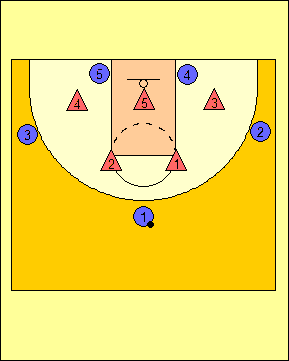
The initial alignment of "2-Down" shows #4 and #5 in the
short corners, #2 and #3 in the gaps just below the
free-throw line extended and #1 at the point with the ball. |
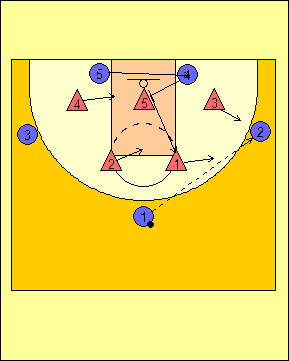
When the ball goes to #2 below the free-throw line extended,
#4 screens the middle man of the zone (X5) and #5 comes
under the screen. As soon as #5 clears on his cut, #4 will
slip the screen to the high post and look for a pass. |
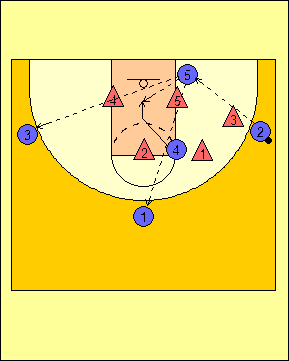
When #2 has the ball, his first pass look is to #5 in the
short corner. When #5 gets the ball, his first pass look is
to #4 as #4 dives to the front of the rim. His second and
third pass looks are to #3 and #1 respectively. |
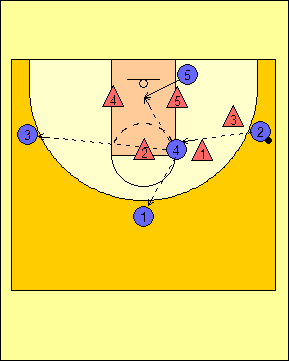
The second pass look for #2 is to #4 in the high post area.
When #4 gets the ball, his first pass look is a high-low
look at #5 going to the basket. His second and third pass
looks are to #3 and #1 respectively. |
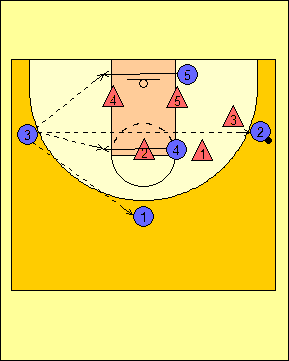
The third pass look for #2 is to make the skip pass to #3 on
the top of the zone. When this happens, #4 and #5 bleed
across. The pass looks, in order, for #3 are #5, #4, #2 and
#1. |
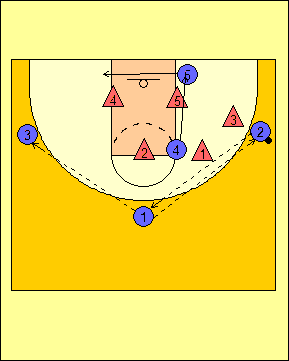
The fourth pass look for #2 is to make the pass back to #1.
When this happens, #4 drops down to the ball-side short
corner as #5 moves to the help-side short corner. From
here, #1's pass looks are the reversal to #3 or back to #2. |
Read the full article and many others by signing up for a Coach Peel
Basketball membership today.
Membership Subscription with Monthly Payments: $6.00 per
month
Membership Subscription with Quarterly Payments:
$15.00 per quarter (save over 16.6%)
Membership Subscription with Annual Payments: $50.00 per
year (save over 30.5% & get your first 30 days free!)

© 2010-2017 Alan Peel Enterprises